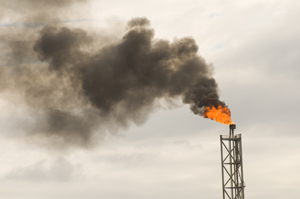Poland's Flame of Hope
on
Poland's Flame of Hope
Poland has pinned its energy hopes for the future on a shale gas miracle. But this dream will not be easily to realize, observe Tim Boersma and Corey Johnson. They argue that Poland would be wise to make its shale gas ambitions part of a 'grand strategy' towards a low-carbon economy.
 |
In late September, the Polish national oil and gas company lit a symbolically important flare of natural gas near Lubocino in northern Poland, which it called a “flame of hope.” The hope is that the layer of subterranean shale rock holds the country’s energy future. Last year the US Energy Information Administration ascribed an enormous reserve of 5.3 trillion cubic meters of natural gas with mining potential to gas shale deposits in Poland. This is almost twice as much as the proven reserves of Norway and the Netherlands combined. This news elevated an already blossoming interest to a top-shelf policy priority in the country.
While European member states such as France and recently Bulgaria opted not to participate for the time being in the global polonaise around shale gas extraction, Poland seems by and large to have embraced this opportunity. But a closer look indicates that the enthusiasm about this resource and ambitious predictions about when the gas will actually be commercially available may be premature.
Commercial exploitation
Amid the haste to develop this source of gas it bears keeping in mind that there still are serious logistical, environmental, and political barriers to shale extraction in Poland. For those banking on widespread commercial development of shale, it is important to note that up to now only a handful of wells has been drilled in Poland and cores are still being analyzed to determine whether commercial exploitation will eventually be possible.
If we assume for the moment that shale gas will flow in Poland, other challenges arise. Poland is a coal country. Electricity generation relies over 95% on coal, while about 50% of Polish households are not connected to gas distribution networks. The bulk of domestic gas consumption takes place in the industrial southwest of the country, but the shale gas reserves are spread from the north to the southeast. In the absence of significant infrastructure to connect the two, it is difficult to imagine a significant domestic market for natural gas. Although new legislation is in the making to accelerate energy infrastructure development, it will take at least six to seven years to realize new gas infrastructure projects. In terms of export, Poland has recently opened interconnectors with Germany and the Czech Republic, and is planning the construction of interconnectors with Denmark, Lithuania and Slovakia. The capacities of these projects do not match the ambitions for supposedly enormous shale gas reserves. The LNG terminal in Swinoujscie, which is to start operating mid 2014, does not significantly alter this picture.
Polish decision makers are aware of the scale of necessary investments. Yet the envisaged solutions – hitting up Brussels and gas consumers to pay for these infrastructure projects – present additional hurdles. Significant increases in gas prices to fund the required investments might erode the public acceptance of shale gas development at an early stage. In addition, Polish government officials expect that European decision makers will soon agree on recently proposed guidelines for trans-European energy infrastructure. Yet given the controversy of this topic in Brussels, and the fact that the proposed regulation would mark the first structural European role in energy infrastructure in history, this scenario may well prove overly optimistic.
Geopolitical intrigue
If the internal and EU dynamics were not enough, some Polish decision makers seem to like backing into the dead end of geopolitical intrigue. To be fair, the longue durée of historical memory in this part of Europe is rooted in war, subjugation, hegemony, and mistrust. The reality is, however, that Russian
| It appears that the hurdles to shale gas development in Poland lie mainly in geologic realities and in the halls of government of Warsaw |
Then there is the issue of the environmental consequences of hydraulic fracturing. The scientific jury on this is still out. There are significant concerns in the United States and Canada about negative impacts on ground water, surface water, seismicity, and climate change. It is too early to establish whether the European institutions will adopt the view that existing EU legislation contains sufficient safeguards to prevent possible negative environmental consequences of shale gas development. Therefore it is incumbent upon authorities in Poland to take all environmental concerns extremely seriously and act as a responsible front-runner within the EU. This has not been the case to date.
Time will tell whether Poland will in fact develop its allegedly enormous reserves of shale gas. Even if large scale exploitation becomes a reality, there are still serious environmental, infrastructural, and economic hurdles to be overcome. We believe the Polish government would serve Polish interests best if they make their shale gas ambitions part of a ‘grand strategy’ towards a low carbon economy, while acknowledging and addressing the environmental concerns that are in fact linked to shale gas exploitation. In addition, implementation of existing European environmental and market legislation pertinent to shale gas seems to be a condition sine qua non. Finally, enormous investments are required to prepare Poland for large scale usage of natural gas, whether for domestic consumption or export. It appears that the hurdles to shale gas development in Poland lie mainly in geologic realities and in the halls of government of Warsaw.
|
About the authors Corey Johnson is a Transatlantic Academy Fellow as well as an assistant professor of political geography at the University of North Carolina, Greensboro. His research focuses on the geopolitical aspects of transnational gas pipelines, in particular from Russia to Europe and more recently also the broader Southern Corridor. |


Discussion (0 comments)